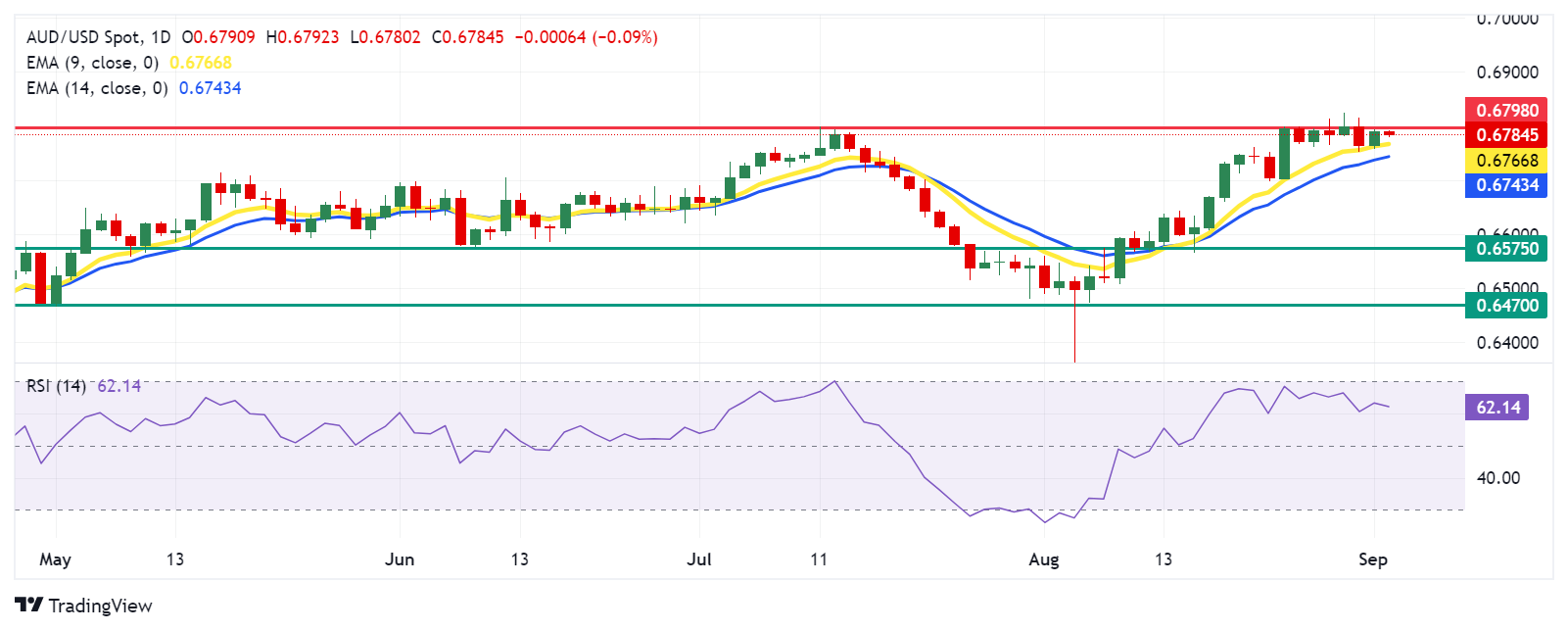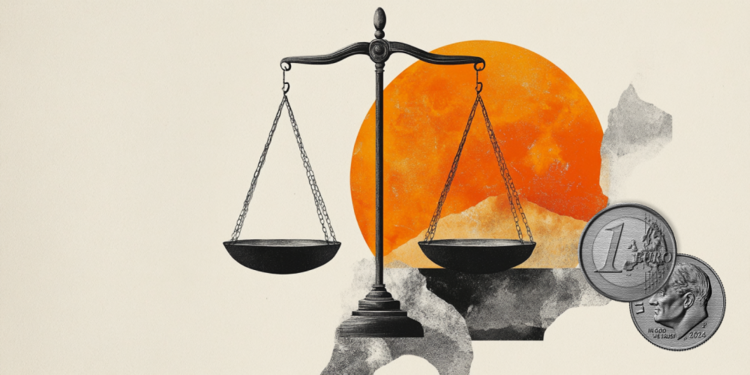- Australian Dollar falls as US Dollar advances on improved Treasury yields.
- The AUD downside could be limited due to improving risk sentiment amid dovish Fed sentiment.
- The US dollar could face challenges due to increased odds of a 25 basis point rate cut by the Fed.
The Australian Dollar (AUD) is down against the US Dollar (USD) as traders await the ISM Manufacturing PMI data due on Tuesday. However, the AUD/USD pair could find some support from improving risk sentiment, driven by rising dovish expectations regarding the US Federal Reserve (Fed) policy outlook.
Traders are now focusing on Australia’s second-quarter gross domestic product (GDP) data and July trade balance data, as well as an upcoming speech by Reserve Bank of Australia (RBA) Governor Michele Bullock later in the week for further insight into the central bank’s hawkish stance on monetary policy.
The US dollar is strengthening as Treasury yields continue to rise, but gains could be limited by rising expectations for a 25 basis point rate cut by the Fed in September. Traders will turn their attention to upcoming US employment data, particularly the Non-Farm Payrolls (NFP) for August, for further insight into the possible timing and magnitude of Fed rate cuts.
Daily Market Wrap: Australian Dollar Falls Despite RBA’s Bold Stance
- Building permits in Australia rose 10.4% month-on-month in July, rebounding sharply from a 6.5% drop in June, marking the strongest growth since May 2023. On an annual basis, the growth rate reached 14.3%, a significant recovery from the previous decline of 3.7%.
- China’s Caixin manufacturing PMI rose to 50.4 in August from 49.8 in July, which is particularly notable given China’s close trading relationship with Australia.
- The U.S. Bureau of Economic Analysis reported on Friday that the headline Personal Consumption Expenditure (PCE) Price Index rose 2.5% year-over-year in July, matching the previous reading of 2.5% but below the 2.6% estimate. Meanwhile, the core PCE, which excludes volatile food and energy prices, rose 2.6% year-over-year in July, consistent with the previous reading of 2.6% but slightly below the consensus of 2.7%.
- The U.S. Gross Domestic Product (GDP) grew at an annualized rate of 3.0% in the second quarter, exceeding both the expected and prior growth rate of 2.8%. In addition, initial jobless claims showed that the number of people applying for unemployment benefits fell to 231,000 in the week ending August 23, from 233,000 previously and slightly below the 232,000 expected.
- Australia’s private capital expenditure unexpectedly declined by 2.2% in the second quarter, reversing an upwardly revised 1.9% expansion in the prior period and below market expectations of a 1.0% increase. This marks the first contraction in new capital expenditure since the third quarter of 2023.
- Australia’s monthly Consumer Price Index (CPI) rose 3.5% year-on-year in July, down from 3.8% in June but slightly above the market consensus of 3.4%. Despite the slight decline, this is the lowest CPI figure since March.
- Atlanta Fed President Raphael Bostic, a prominent hawk on the FOMC, indicated last week that it may be “time to act” on rate cuts due to a further slowdown in inflation and a higher-than-expected unemployment rate. FXStreet’s FedTracker, which measures the tone of Fed officials’ speeches on a dovish-to-hawkish scale from 0 to 10 using a custom AI model, rated Bostic’s words as neutral with a score of 5.6.
Technical Analysis: Australian Dollar Holds Above 0.6750
The Australian dollar is trading around 0.6780 on Tuesday. Looking at the daily chart, the AUD/USD pair is positioned above the nine-day exponential moving average (EMA), suggesting a short-term bullish trend. Moreover, the 14-day Relative Strength Index (RSI) is holding above the 50 level, reinforcing the overall bullish trend.
In terms of resistance, the AUD/USD pair could challenge the immediate barrier at the seven-month high of 0.6798. A break above this level could strengthen the ongoing bullish momentum, potentially pushing the pair towards the psychological level of 0.6900.
On the downside, the AUD/USD pair could test the immediate support around the nine-day EMA at 0.6767, followed by the 14-day EMA at 0.6743. A break below these EMAs could weaken the bullish bias and increase the downside pressure, potentially leading the pair towards the retracement level at 0.6575, with a possible further drop towards the lower support at 0.6470.
AUD/USD: Daily Chart
Australian Dollar PRICE Today
The table below shows the Australian Dollar (AUD) exchange rate against major currencies today. The Australian Dollar was the weakest currency against the US Dollar.
| USD | EUR | GBP | JPY | CAD | AUD | NZD | CHF | |
|---|---|---|---|---|---|---|---|---|
| USD | 0.08% | 0.05% | 0.10% | 0.04% | 0.10% | 0.30% | 0.11% | |
| EUR | -0.08% | -0.03% | 0.03% | -0.05% | 0.01% | 0.12% | 0.03% | |
| GBP | -0.05% | 0.03% | 0.06% | -0.01% | 0.06% | 0.15% | 0.07% | |
| JPY | -0.10% | -0.03% | -0.06% | -0.09% | -0.03% | -0.01% | -0.02% | |
| CAD | -0.04% | 0.05% | 0.01% | 0.09% | 0.04% | 0.07% | 0.08% | |
| AUD | -0.10% | -0.01% | -0.06% | 0.03% | -0.04% | -0.01% | 0.01% | |
| NZD | -0.30% | -0.12% | -0.15% | 0.01% | -0.07% | 0.00% | 0.02% | |
| CHF | -0.11% | -0.03% | -0.07% | 0.02% | -0.08% | -0.01% | -0.02% |
The heatmap shows percentage changes of major currencies. The base currency is selected from the left column, while the quote currency is selected from the top row. For example, if you choose the Australian Dollar from the left column and move along the horizontal line to the US Dollar, the percentage change shown in the chart will represent the AUD (base)/USD (quote).
Australian Dollar FAQs
One of the most important factors for the Australian Dollar (AUD) is the level of interest rates set by the Reserve Bank of Australia (RBA). Since Australia is a resource-rich country, another key factor is the price of its largest export, iron ore. The health of the Chinese economy, its largest trading partner, is a factor, as is inflation in Australia, its growth rate and the Trade Balance. Market sentiment, i.e. whether investors are betting on riskier assets (risk-on) or seeking safe havens (risk-off), is also a factor, with risk-on being positive for the AUD.
The Reserve Bank of Australia (RBA) influences the Australian Dollar (AUD) by setting the level of interest rates that Australian banks can lend to each other. This influences the level of interest rates in the economy as a whole. The RBA’s main objective is to maintain a stable inflation rate of 2%-3% by adjusting interest rates up or down. Relatively high interest rates compared to other major central banks support the AUD, and the opposite for relatively low ones. The RBA can also use quantitative easing and tightening to influence credit conditions, with the former being negative for the AUD and the latter positive for the AUD.
China is Australia’s largest trading partner, so the health of the Chinese economy greatly influences the value of the Australian Dollar (AUD). When the Chinese economy is doing well, it buys more raw materials, goods and services from Australia, which increases demand for the AUD and drives up its value. The opposite occurs when the Chinese economy is not growing as fast as expected. Therefore, positive or negative surprises in Chinese growth data often have a direct impact on the Australian Dollar.
Iron ore is Australia’s largest export, worth $118 billion per year as of 2021 data, with China being its main destination. The price of iron ore can therefore be a driver of the Australian dollar. Typically, if the price of iron ore rises, the AUD rises as well, as aggregate demand for the currency increases. The opposite occurs when the price of iron ore falls. Higher iron ore prices also tend to lead to a higher probability of a positive trade balance for Australia, which is also positive for the AUD.
The trade balance, which is the difference between what a country earns from its exports and what it pays for its imports, is another factor that can influence the value of the Australian dollar. If Australia produces highly sought-after exports, its currency will gain value solely because of the excess demand created by foreign buyers wanting to purchase its exports versus what it spends on buying imports. Therefore, a positive net trade balance strengthens the AUD, with the opposite effect if the trade balance is negative.
Source: Fx Street
I am Joshua Winder, a senior-level journalist and editor at World Stock Market. I specialize in covering news related to the stock market and economic trends. With more than 8 years of experience in this field, I have become an expert in financial reporting.








